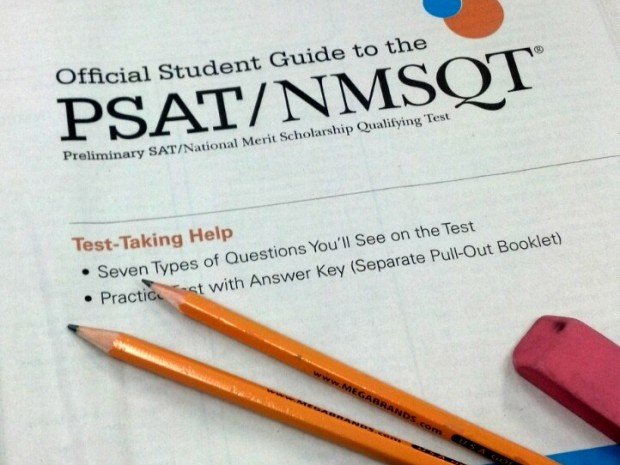Should merit scholarships consider income? YES
The current NMSQT system allocates scholarships by state, others propose a system based on income brackets
Courtesy of Anthony-James Green
Juniors recently recieved results from the NMSQT, which gives merit scholarships.
The College Board describes itself as an “organization committed to excellence and equity in education.” The Preliminary Scholastic Aptitude Test (PSAT) is administered with the supposed aim of giving students the opportunity to practice under testing conditions to achieve greater success on the Scholastic Aptitude Test (SAT). However, the test also serves a much larger purpose: to select students worthy of National Merit Scholarships. Each year, over 1.5 million high school juniors take the PSAT in hopes of either using as little energy as possible in order to get out of school by noon, or to acquire a substantial amount of money for college tuition. For those that seek the 8,900 scholarships offered, the current system is created with little attention paid to the “equity” that the College Board claims to stand for.
The state cutoff system, which sets a score for which students in each state must exceed, uses a simple mechanism of taking the 99 percentile from every state. But by clustering thousands of students of extremely different backgrounds into state groups, the system fails in maintaining equity.
Take the District of Columbia, with a poverty rate of 18.0 percent in 2012, compared to the national average of 15.0 percent, and where 49.5 percent of its residents are African American. This territory had the highest cutoff for the class of 2015 at a score of 224 out of 240. Then look at North Dakota, which has a poverty rate of 11.9 percent and a white population of 89.6 percent. It had the lowest cutoff, along with West Virginia, of 201. North Dakota ranked sixth out of the 50 states in Education Week’s annual state rankings on quality of education for 2014. Here in California, we have a poverty rate of 23.5 percent and are ranked 41st in quality of education. Yet this immensely diverse state has the fourth highest cutoff in the nation at 222.
The data yields no explanation for the College Board’s choice state cutoffs, a possible reason for the extreme lack of transparency in how these numbers are created.
If the PSAT is an attempt to give equitable rankings of students achieving great academic success, it has failed in eliminating the advantages and disadvantages of all high schoolers so as to find those worthy of recognition and scholarships. The only consolation the College Board attempts to provide to its inherent bias towards the wealthy is in the National Hispanic Recognition Program (NHRP), which does not even provide scholarships for the students.
The SAT’s bias in favor of the wealthy becomes apparent in the unbroken trend of increasing family incomes yielding higher scores on average. Students with family incomes between $0-$20,000 score 400 points lower than those with family incomes of $200,000 or more. This has been attributed to the factors that decreasing levels of financial security often comes with single-mothers, lower levels of parental education and less academic support (i.e. paid tutors or private schools).
In order to reward students for the greater work ethic and passion required to succeed without financial security, the PSAT cutoffs ought to be based on income brackets. This eliminates the current disregard for intrastate diversity and honors each student for his or her individual background. In this way, students with family incomes of $0-$20,000 would need to score a 200, $20,000-$40,000 would require a 205 and so forth. Recognition should be given to all students that score above a chosen number, 210 for instance, but the distribution of scholarships ought to favor the socioeconomically disadvantaged not only for their need for financial aid, but also due to the greater challenges they had to overcome to achieve academic success.
Your donation will support the student journalists of Palo Alto High School's newspaper

